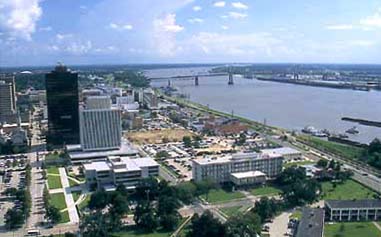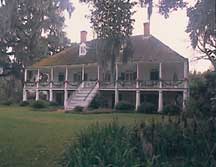-
-
-
-
-
-
-
-
-
-
-
-
-
-
Louisiana
-
-
-
-
-
-
-
-
-
-
-
-
-
-
-
| Map of the Bartram Trail |
To the Mississippi and Back, 1775
 |
|
| The north shore of Lake Pontchartrain |
There he stayed four or five weeks before he recovered sufficiently to stroll about “through its awful shades, venerable groves and sublime forests, consisting of the Live Oaks and Magnolia grandiflora, etc.… The island is six or seven miles in length, and four or five in width, including the salt marshes and plains at the South end of it, washed by Lake Borgne at the Regullets [Rigolets], which is a promontory composed of banks of sea shells(147) and sand cast up by the force of winds and the surf of the lake.”(148)
His eyes “having acquired sufficient strength to endure the open day light,” Bartram left Pearl Island “for Manchac on the Mississippi” by boat.(149) He entered Lake Pontchartrain near the Rigolets and traveled close to its north shore. Stopping briefly at the mouth (150) the present Pass Manchac. They traveled up the Amite River from the lake. Bartram stopped at “a very large plantation the property of a Scotch gentleman”(151) in the vicinity of Head of Island or French Settlement. “About twenty miles farther,” Bartram debarked from his boat (at the merging of the Iberville and Amite) and proceeded by land to Manchac on the Mississippi.
Bartram followed the river north to Baton Rouge stopping at the Indian town of Alabama (near present Burtville or Gardere). At Baton Rouge, Bartram evidently stayed at the plantation of William Dunbar (1749–1810) a Scottish gentleman, who shared many of Bartram’s interests.(152)
 |
|
| Baton Rouge and the Mississippi River |
It has been suggested by at least one historian that sufficient circumstantial evidence exists to indicate that Bartram’s trip to the White Cliffs (Brown Cliffs) was prompted by political considerations and not merely scientific curiosity. Mr. Fred G. Benton, Jr. of Baton Rouge, Louisiana, believes that Bartram was commissioned by Governor Brown and the colonial government of West Florida to examine and report on the Brown Cliffs and White Plains area which was then being considered as a possible site for a relocated West Floridian capital. He cites Bartram’s meetings with Governors Chester and Brown and his willingness to travel to these locations, despite an extremely severe and dangerous medical condition, as evidence for his hypothesis.(155)
 |
|
| Parlange, c. 1750, Pointe Coupee Parish |
Returning to Baton Rouge, Bartram and his companion (companions?) stopped again briefly at the Cliffs.
His eyes still bothering him, he had to cut short “the plan of my peregrinations” and “return to Carolina.”(156) He sailed from Manchac as he had come: down the Amite, across Lake Maurepas, through the “streights” and into Lake Pontchartrain. His yaw ran aground near the west shore of the lake, but eventually was washed free and allowed him to continue “through the Regullets” and into the Gulf at the Bay of Pearls.(157) Bartram left Louisiana in November, 1775, about a month after he had entered the present boundary of the state.
Footnotes
145. Bartram’s Travels p. 419, Harper, p. 266.
N.B. Page numbers for all Bartram quotations will be given in the following way: The first page number cited will be the page on which the passage appears in the first (Philadelphia 1791) edition of the book; the second page number will be the page on which the passage appears in Francis Harper’s Naturalist’s Edition. For convenience in checking the original source, Harper’s edition provides both systems of pagination. When third or fourth numbers appear, they refer to Harper’s commentary, also in the Naturalist’s Edition.
146. The location of Pearl Island has been the subject of much debate and controversy. For Francis Harper’s opinion on the location, see his Naturalist’s Edition, p. 589. See also F. Benton and J. Stevens, Bartram Trail Conference Technical Studies, op. cit.
147. These shells are of the genus Rangia. For further information on this and other natural history topics from the Gulf Coast, see: US Fish and Wildlife Service publication, Gulf of Mexico; Its Origin, Waters and Marine Life, Washington, DC, 1954.
148. Ibid., p. 421, Harper, p. 267.
149. Ibid., p. 423, Harper, p. 268.
150. Ibid., p. 425, Harper, p. 269.
151. Ibid., p. 426, Harper, p. 270.
152. Dunbar’s better known plantation called “the Forest” was established near Natchez, Mississippi, in 1792. From here Dunbar corresponded with Thomas Jefferson and others. In a letter to Bartram dated September 2, 1810, Alexander Wilson wrote: “Mr. Dunbar, of Natchez remembered you very well, and desired me to carry his good wishes to you” (Ord, 1825). For further information on Dunbar, see: D. Rowand, Life and Papers of William Dunbar, Mississippi Historical Society, 1930.
153. Bartram’s Travels, op. cit., p. 430, Harper, p. 272–273.
154. Ibid., p. 431, Harper, p. 273.
155. For further discussion of this theory, see Fred Benton, “Location of Bartram’s Travels in Louisiana,” Bartram Trail Conference Technical Study, 1978, on file with the Bartram Trail Conference. (Part II of this book pertains to this subject.)
156. Ibid., p. 136, Harper, p. 276.
157. Ibid., p. 437, Harper, p. 277.

